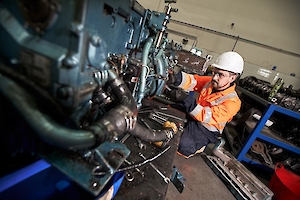The main purpose of a coolant is to keep an industrial engine working at its optimum temperature, but it actually provides a variety of benefits. Here Keith Andrews, Original Equipment Manufacturer (OEM) Account Manager at DiPerk Power Solutions, exclusive supplier of Perkins® engines and parts in the UK and Ireland, gives advice on monitoring a coolant to extend an industrial engine’s life span.
Coolant circulates additives, such as pH stabilisers, anti-foaming agents and protective agents for rubber and plastic components around the engine. It also prevents damage to the pistons, cylinders, bearings and crankshaft.
High quality coolant can protect the metal in the engine from corrosion. Engine heat transfer systems are commonly made of six basic metal alloys, including copper, brass and cast iron. These metal alloys react with water, leading to corrosion that can cause thinning and failure of pipes, damage to water pumps, thermostats and operating valves and blockages in narrow spaces of radiators.
There are several coolant options on the market. The main types are standard heavy-duty, fully formulated products and long life or extended life coolants (LLC or ELC). Heavy-duty products have corrosion inhibitors that are used up over time and therefore require testing every six months to see if corrosion inhibitors need topping up. The main advantage of an LLC/ELC is that its service life is typically twice as long as heavy-duty products, so it does not require as much testing. Whichever coolant you choose, using a water-based coolant with suitable anti-corrosion additives will better protect from corrosion and extend engine lifespan.
Monitoring fluid condition
Regardless of the type of coolant you are using, we recommend you follow the maintenance regime appropriate for the engine to monitor for leaks, corrosion and cavitation, as well as to extend the fluid’s lifespan.
Regular fluid analysis will give operators a detailed insight into what is happening inside the engine. By analysing fluid samples, third-party specialists can detect trace metals caused by wear or corrosion in internal components using the unique metallurgy and rate of wear to determine which parts are most likely to be damaged. Engineers can regularly submit samples to a specialist laboratory, such as DiPerk’s facility in Leeds, UK, to receive analysis reports that recommend actions to help increase engine lifespan.
Consider this example — a standby generator is not frequently used or monitored, so corrosion has occurred. When it is next in use, a build-up of sediment has blocked components, such as cylinders and pipes, which causes the engine to overheat, damaging internal parts such as the radiator, and ultimately leading to engine failure. Another possible issue if coolant is not maintained is that coolant can leak into the engine’s lubrication system, contaminating and thickening the oil and ultimately exposing moving parts and surfaces to wear.
Thankfully, with regular fluid analysis, engine operators can easily detect issues early on, take steps to address them and keep their engines in service for a long and happy life.


